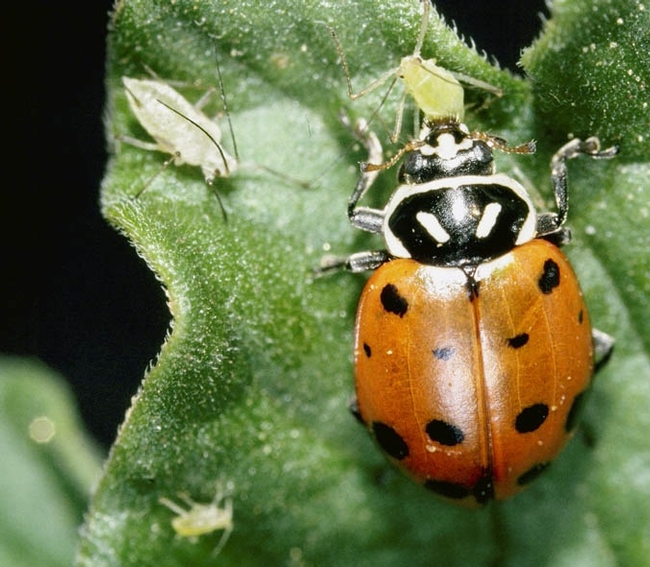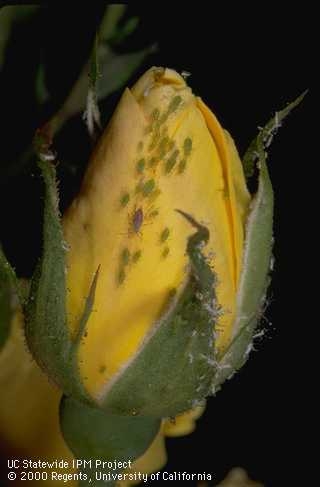Posts Tagged: aphids
The Hitchhiker
Oleander aphids, those cartoonish-looking yellow insects with black legs and cornicles, are commonly found on oleanders. Hence their name. But they...
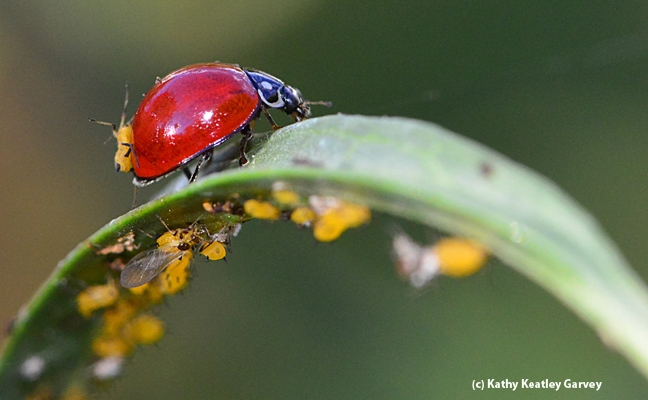
A lady beetle picks up a hitchhiker, an oleander aphid. (Photo by Kathy Keatley Garvey)
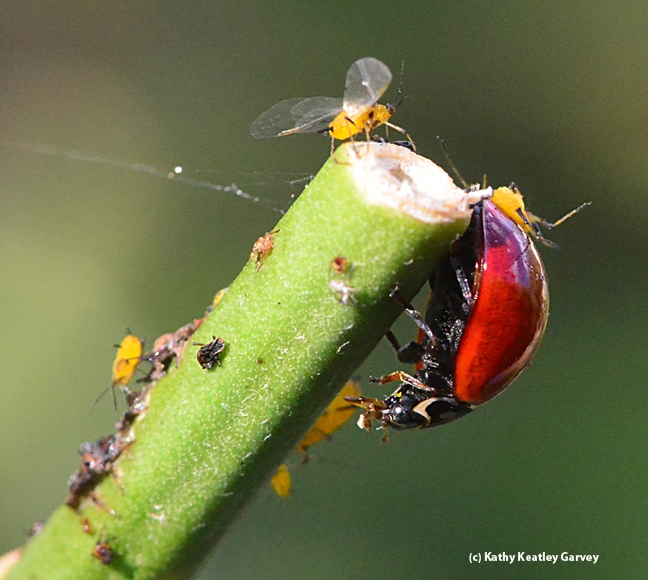
One on the back and one in the mouth. (Photo by Kathy Keatley Garvey)
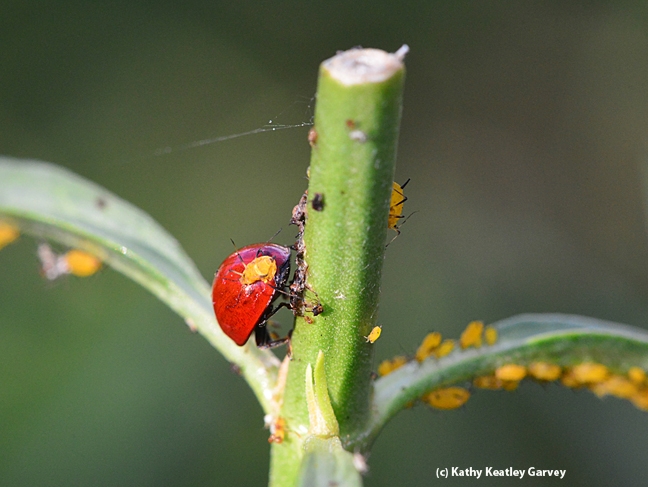
The oleander aphid maintains its hold on the back of its predator, a lady beetle. (Photo by Kathy Keatley Garvey)
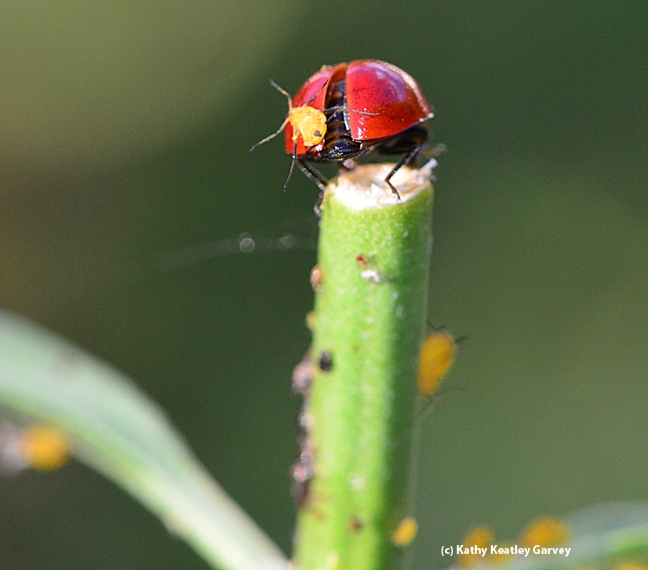
The lady beetle prepares for take-off, with the oleander aphid still clinging to its back. (Photo by Kathy Keatley Garvey)
Lady bugs need special care to control aphids in the garden
Many retail nurseries and garden centers sell lady beetles for controlling aphids in gardens and landscapes. Gardeners often ask, “Does releasing lady beetles really work?”
Lady beetles sold at nurseries for aphid control are convergent lady beetles, named for the converging white marks on its thorax. Suppliers collect beetles from large overwintering aggregations in California's foothills and mountains. Many other species of lady beetles occur naturally in California landscapes but don't aggregate in the mountains and aren't sold commercially.
University of California research has demonstrated that lady beetle releases can effectively control aphids in a limited landscape or garden area if properly handled and applied in sufficient numbers. However, because of inadequate release rates or poor quality, lady beetles often fail to provide satisfactory control. Other low toxicity aphid management practices, such as hosing off or insecticidal soap or oil sprays, may be more effective. Here are some things to consider if you decide to try lady beetle releases:
Lady beetles deteriorate rapidly if not handled properly. Lady beetles need to be kept refrigerated until they are released. Live lady beetles on display in stores are attractive for customers, but beetles left out at room temperature rapidly deteriorate. Also, lady beetles are often dehydrated and need water, especially if they have been held at room temperature, even for a few hours. Stores or gardeners are advised to mist lady beetles with water in a squirt bottle before placing them in the refrigerator for storage, making sure not to let water puddle in containers. When purchasing lady beetles, inspect the container and make sure almost all beetles are alive. Lady beetles purchased from primary suppliers (those who obtain beetles directly from collectors) may be healthier than those held in stores for several weeks.
Use adequate release rates. UC research shows that high numbers of lady beetles are required to control aphids. One large, heavily infested rose bush in the landscape required two applications of about 1,500 lady beetles each, spaced a week apart. Most packages sold in stores contain only enough lady beetles to treat one aphid-infested shrub or a few small plants. Larger qualities can be purchased from online lady beetle suppliers.
Lady beetles need a good supply of aphids. There is no point in releasing them on plants with few aphids. Lady beetles are voracious aphid feeders and an adult beetle will eat 50 or more aphids a day. The convergent lady beetle, which is the species sold for release, feeds almost entirely on aphids and will not remain on plants with low aphid populations and will not control other garden pests.
Release lady beetles at dusk or early evening. Lady beetles will fly away almost immediately if released during the heat of the day or where the sun is shining, so wait until evening to release them. Spray a fine mist of water on the plants before the release. Giving beetles a drink may keep them around longer. Place beetles at the base of plants or in the crotches of low branches. Lady beetles will crawl higher into the plant in search of aphids. Once lady beetles begin to fly, they are likely to fly a substantial distance, often outside the boundaries of your garden. Don't release lady beetles on plants that have been sprayed with insecticides. Residues from most insecticides are likely to kill the beetles. However, insecticidal soaps and oils, once dry, won't leave toxic residues.
Expect lady beetles to fly away in a few days. Even when released with care, lady beetles will fly away within a few days. About 95 percent of released beetles in research studies flew away within 48 hours. The remainder were gone within 4 or 5 days. Lady beetles are unlikely to lay eggs on the plants they are released on. If aphids return a week or two later, gardeners will need to release more lady beetles, hose aphids off with water, use insecticidal soap sprays, or wait for other native aphid natural enemies to fly in.
See the convergent lady beetle page in UC IPM's Natural Enemies Gallery for information about its life cycle and view journal articles about UC research on lady beetle releases for controlling aphids.
This article was modified from the original version published in the June 2011 issue of the Retail Nursery and Garden Center IPM News.
What's for Lunch?
What's for lunch? If you're a lady beetle (aka ladybug), a good bet is you'll have one of those yummy, plant-sucking aphids. In fact, you'll eat...
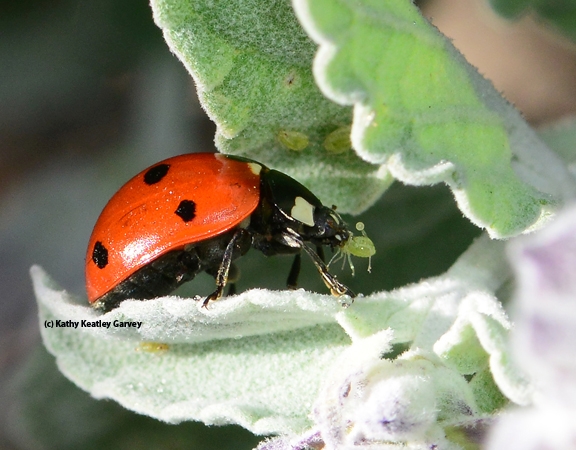
Lady beetle, aka ladybug, devouring an aphid. (Photo by Kathy Keatley Garvey)
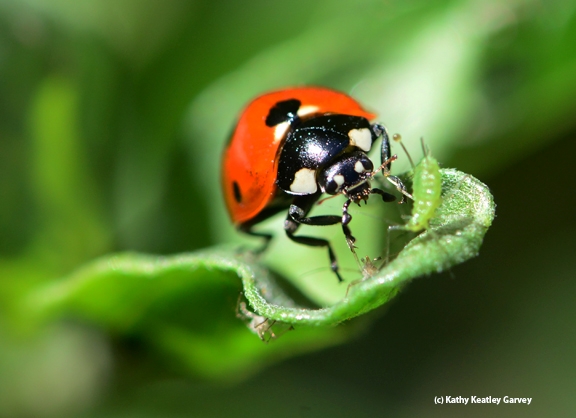
Predator and the prey. (Photo by Kathy Keatley Garvey)
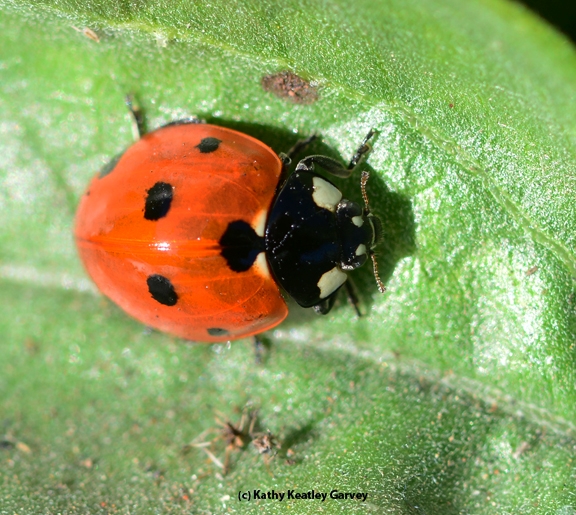
Saturated. (Photo by Kathy Keatley Garvey)
Treating landscape pests with oils is safe for people and pets
Oils are some of the most useful pesticides available for managing pests on woody ornamentals and fruit trees. They are also widely used on many herbaceous flowers and vegetables. Oils control a range of soft-bodied insects and mites, as well as several foliar diseases including powdery mildew (Table 1). Not only do oils leave no toxic residues, they are safe to use around people, pets, and wildlife; have low impact on beneficial insects; and won't harm honey bees unless applied directly to flowers during the time of day that bees are foraging.
Oils used for managing pests on plants are most often called horticultural oils. Horticultural oils are derived from petroleum sources, and are sometimes called mineral oil, narrow range oil or superior oil. Other oils produced to control pests may be made from plants, such as canola oil, neem oil or cottonseed oil. A number of other plant extract oils have also recently become available on the market.
How they work
Regardless of their source, the primary way oils kill insects and mites is the same — by suffocation. Insects breathe through structures called spiracles. Oils block spiracles, reducing the availability of oxygen and interfering with various metabolic processes. When applied to insect or mite eggs, oils can penetrate the shells and kill the developing embryo. Oils may also act as a repellent in some cases, especially with some of the plant-based oils, and some such as neem oil have anti-feeding properties.
Because oils kill by smothering insects, apply the product so it completely covers the target pests. Careful attention must be paid to treat both the underside and topside of leaves, buds, and shoots and all locations where the insects or mites may be located. Spraying during the dormant season, when leaves are off trees or shrubs, is recommended for scales and some other insects, because it is easier to get good coverage on leafless trees. Because oils leave no toxic residues, they won't generally kill insects that move onto plants after treatment.
Usually, immature stages of insects are most susceptible, especially with scale insects, mealybugs and true bugs. Insects that feed within curled leaves, such as leaf-curling aphids, leaf miners, or gall-forming species, are protected from oil sprays and not well controlled. Oils don't control caterpillars, beetles, grasshoppers, and boring insects, with the exception of some caterpillars in the egg stage.
In some cases, oils improve the efficacy of other insecticides. For instance, applications of both codling moth granulosis virus (Cyd-X) and spinosad are more effective against codling moth when 1% oil is added to the spray.
For managing certain foliar diseases such as powdery mildew, oils can act as both a preventive and a curative fungicide, smothering fungal growth and inhibiting spore production. In many cases, the efficacy of oils in reducing powdery mildew is superior to standard synthetic fungicides, especially in reducing existing infections.
Tips to know
All oils now sold as pesticides are highly refined and can be used safely on most plants throughout most of the year, unless plants are drought-stressed. Exceptions include Japanese and red maples, walnuts and smoke tree. Redbud, juniper, cedar, spruce and Douglas-fir are also sometimes injured. Injury usually involves discoloration of leaves or needles. Walnut is very sensitive to oil sprays applied during bud break, and applications aren't recommended during the dormant season because of potential damage to buds and shoots.
Many plants are sensitive to oil damage when water-stressed, so be sure plants have been adequately irrigated before application. Most oil labels also warn against applying oils when temperatures are below freezing or above 90°F. Oils shouldn't be applied in combination with sulfur, or within 30 days of a sulfur application, because of potential phytotoxicity. As with any pesticide, always check product labels for precautions or other restrictions before applying.
|
Dormant-season applications |
|
|
Spring and summer—foliar applications |
|
This article is from the May 2013 issue of the UC IPM Green Bulletin. This issue of the bulletin also contains these articles:
- What Can Landscape Managers Do to Help Honey Bees?
- Pesticide MSDS Format Changes
- New Active Ingredient Available for Snails, Slugs
- Visit UC IPM's Web Site for Free Online Training
- Revised Resources
- Ask the Expert: bee sting hazards, insecticidal soaps
Ladybugs Coming Up in the World
Decisions, decisions... Where's the best spot for the new residents of my garden? I acquired two ladybugs last Saturday during the 99th annual UC...
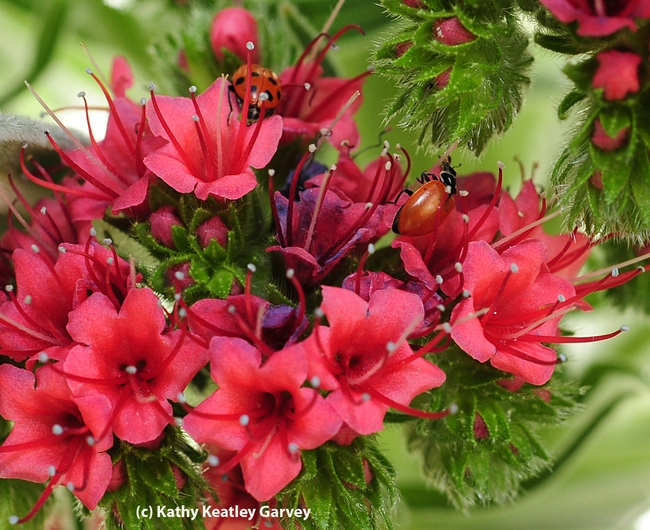
Two ladybugs in a tower of jewels, Echium wildpretii. (Photo by Kathy Keatley Garvey)
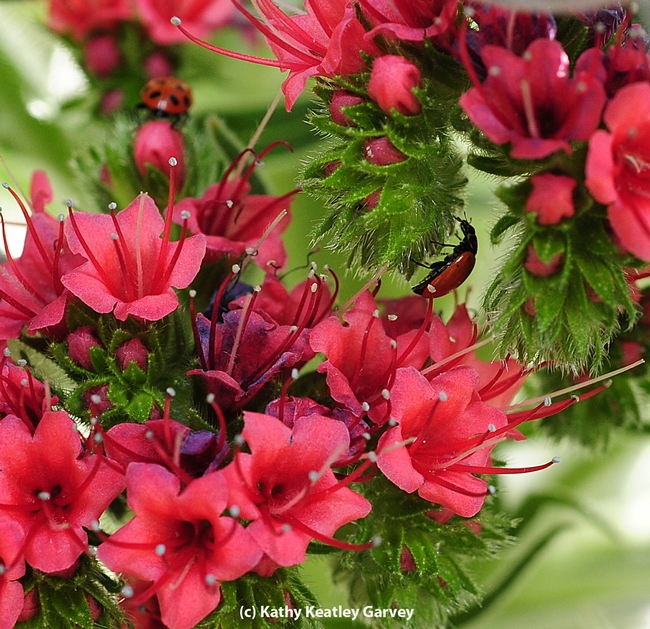
Ladybugs exploring the menu. (Photo by Kathy Keatley Garvey)
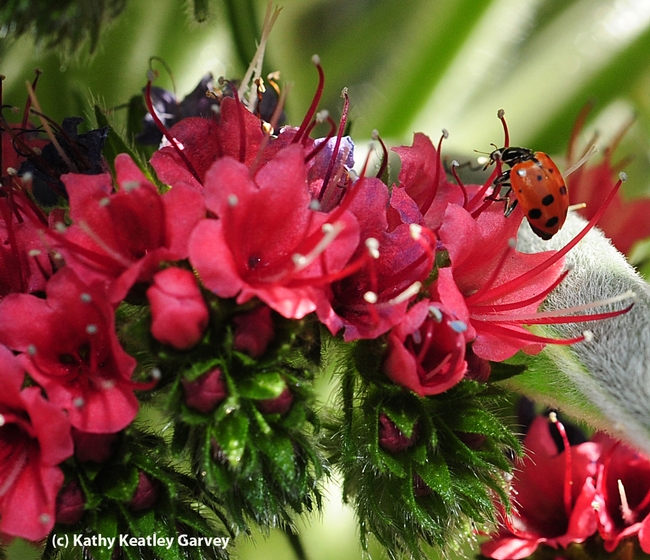
Hmm, looks like an aphid over there to me. (Photo by Kathy Keatley Garvey)


